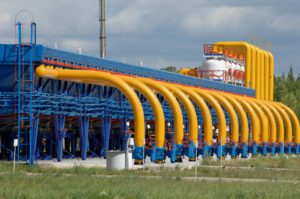
Transit of natural gas through the gas transmission system (GTS) of Ukraine in January-July 2021 amounted to 25.616 billion cubic meters, which is 14.1% less than in the same period in 2020 (29.82 billion cubic meters), according to the data of Gas Transmission System Operator of Ukraine (GTSOU).
In particular, in January, transit amounted to 3.863 billion cubic meters (124.6 million cubic meters per day), in February – 2.907 billion cubic meters (103.8 million cubic meters per day), in March – 3.694 billion cubic meters (119.2 million cubic meters per day), in April – 3.718 billion cubic meters (123.9 million cubic meters per day), in May – 3.86 billion cubic meters (124.5 million cubic meters per day), in June – 3.723 billion cubic meters (124.1 million cubic meters per day), in July – 3.851 billion cubic meters (124.2 million cubic meters per day).
According to the press service of the company, in particular, 23.3 billion cubic meters of gas were transported by transit in the western directions (Slovakia – 15.8 billion cubic meters, Hungary – 5.3 billion cubic meters, Poland – 2.2 billion cubic meters), in the south – 2.3 billion cubic meters (Moldova – 1.9 billion cubic meters, Romania – 400 million cubic meters).
GTSOU notes that in July Gazprom used all previously booked capacities, but showed no interest in additional transit capacities, despite the record growth in prices in European gas markets, as well as low volumes in European storage facilities and the planned stop of Yamal-Europe routes and Nord Stream 1.
According to GTSOU Director General Serhiy Makogon, Gazprom is emptying its UGS facilities in Europe in order to compensate Europeans for the lost gas volumes, and at the same time not to increase additional transit through Ukraine.

Federal Minister of Finance of the Federal Republic of Germany Olaf Scholz said that Germany will seek the extension of the agreement on gas transit through Ukraine.
“We work very hard to make sure that the gas transit agreement between Ukraine and Russia is prolonged,” Scholz said in an interview with Bloomberg on Friday.
According to the position of Germany, the Nord Stream 2 gas pipeline, which runs along the bottom of the Baltic Sea, should be finished, but gas transit through Ukraine should be preserved.
According to Scholz, Germany sees its responsibility to ensure transit through Ukraine in the future, and not only for two or three years, but for decades to come.
The current agreement, according to Government Spokesperson Steffen Seibert, is valid until at least 2024, but the agreement implies that the parties will check the possibility of extending the agreement until 2034.

Transit of gas through Ukraine should remain even after the construction of Nord Stream 2, German Foreign Minister Heiko Maas said.
Maas told journalists in Berlin on Wednesday that Chancellor Angela Merkel told Russian President Vladimir Putin long ago that for Germany, the completion of the construction of Nord Stream 2 is associated with the need for further gas transit through Ukraine.
According to him, nothing will change in Germany’s position in this regard.

Transit of natural gas through the gas transmission system (GTS) of Ukraine in January-April 2021 amounted to 14.1 billion cubic meters, which is 9% less than in the same period in 2020 (15.5 billion cubic meters), according to the statement of Gas Transmission System Operator of Ukraine LLC (GTSOU).
In particular, 12.5 billion cubic meters of gas were supplied in the western direction as transit (8.4 billion cubic meters to Slovakia, 2.9 billion cubic meters to Hungary, 1.2 billion cubic meters to Poland), 1.7 billion cubic meters to the south (1.3 billion cubic meters to Moldova, and 0.4 billion cubic meters to Romania).
According to Commercial Director of the operator Yevhen Todorov, GTSOU put up for auction for the distribution of additional capacities at interstate entry points from the Russian Federation for May 2021. However, market participants, in particular the Russian side, did not show interest in the proposal.
“Taking into account the seasonal market demand for gas in the EU and limited transportation volumes, starting from April 1, 2021, the price at gas hubs has shown an increase and from the beginning of the year to May 12, it has increased by 36%, to EUR 26.4 per MWh at the NCG hub on condition of delivery one day ahead (about EUR 279 per 1,000 cubic meters),” he said.
In addition, gas transportation from Europe to Ukraine in January-April 2021 amounted to 0.55 billion cubic meters, which is seven times less than in the same period in 2020 (3.87 billion cubic meters). Ukraine received 0.07 billion cubic meters of gas from NCG, 0.48 billion cubic meters from Hungary, while almost no gas was delivered to the country from Poland, Romania and Moldova.
Gas supplies as virtual reverse flow to Ukraine amounted to 0.49 billion cubic meters, or almost 90% of transportation. Gas flow in the “customs warehouse” mode amounted to 0.08 billion cubic meters versus 1.22 billion cubic meters in the same period in 2020.
Gas re-export from Ukraine in the four months ended April 2021 amounted to 0.68 billion cubic meters, while for the whole last year traders almost did not order re-export services.

Gazprom is thus far keeping to a stable approach to the use of Ukrainian transit capacities.
“You see our bookings. Our bookings are visible. Thus far, we remain at the same level,” Gazprom deputy head Elena Burmistrova said during Investor Day when asked about the prospects of increasing transit.
“We’ve had a very difficult winter in Europe, in Russia, in Asia. So we are now looking at our balances and resources – and looking at how we are going to move forward following the end of Q1,” she said.
In April, Gazprom pumps an average of 124 million cubic meters per day through Ukraine, fully using booked volume.
Europe is experiencing a notable shortage of gas for pumping into underground gas storage facilities.
Last Friday, the Ukrainian GTS Operator unexpectedly announced an auction for additional gas pumping to Europe in May in volume of half of current supplies: 64 million cubic meters per day above the current pumping capacity of 124 million cubic meters. However, capacity was left unused following the auction.

Naftogaz Group reduced capital expenditures (capex) by 44.5% (or by UAH 12.193 billion) in 2020 compared to 2019, to UAH 15.044 billion.
As indicated in the consolidated statements of the group published on Tuesday, capex of the exploration and production segment was UAH 11.023 billion (a fall of 26.2% to 2019), oil midstream and downstream – UAH 1.185 billion (a fall of 35.4%), Ukrnafta – UAH 1.113 billion (a fall of 23%), gas storage – UAH 0.143 billion (a rise of 3.3 times), commerce – UAH 0.133 billion (a rise of 11.1 times), other – UAH 1.448 billion (a fall of 83.8%).
As reported, the consolidated net loss of NJSC Naftogaz Ukrainy in 2020 amounted to UAH 19.002 billion compared to a net profit of UAH 63.294 billion in 2019. Excluding the results of the discontinued operations, including the Gas Transit Arbitration award of UAH 55.7 billion, the net profit was UAH 2.6 billion.
Naftogaz’s revenues in 2020 grew by 27.1% (by UAH 41.184 billion) compared to 2019, to UAH 193.017 billion, including income from sales being UAH 159.234 billion (a rise of 6.3%), compensation for performing public service obligations totaling UAH 32.205 billion (a rise of 100%), and interest and other income reaching UAH 1.578 billion (a fall of 23.1%).
The net loss of NJSC Naftogaz Ukrainy, as a separate legal entity, in 2020 amounted to UAH 18.002 billion versus UAH 50.658 billion of net profit for 2019. Net income last year decreased 32.1% compared to 2019, to UAH 121.059 billion.